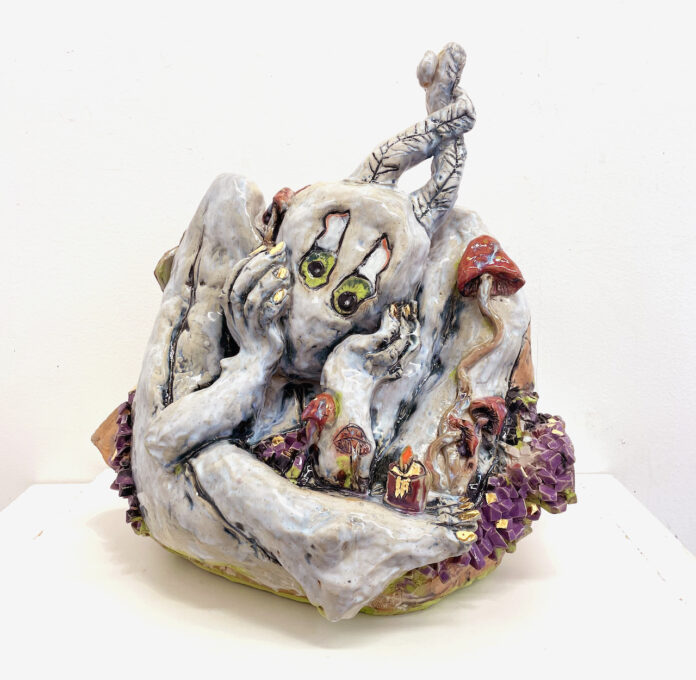Emerson Dorsch Presents Judd Schiffman: Mothman in the Bardo
Dorsch is proud to present Mothman in the Bardo, an exhibition of new works by Judd Schiffman. The exhibition opens with a reception on Thursday, September 19th, from 6pm to 9pm, and will be on view through November 2, 2024.
Schiffman’s work delves into the realms of mythology, personal reflection, and spirituality. Through a variety of media, he explores the intersections between these themes, creating a unique and thought-provoking visual language.
Mothman in the Bardo invites viewers to embark on a journey through Schiffman’s artistic vision. Encountering mythological symbolism alongside introspective narratives, audiences will experience a space where personal and universal truths intertwine.
Exhibition Details:
- Artist: Judd Schiffman
- Exhibition Title: Mothman in the Bardo
- Dates: September 19 – November 2, 2024
- Reception: Thursday, September 19, 6pm – 9pm
- Location: Emerson Dorsch, 5900 NW 2nd Ave, Miami FL. 33127
About the Artist:
Judd Schiffman is a multidisciplinary artist whose work explores the boundaries between the personal and the universal. Through his use of mythological symbolism and spiritual exploration, he creates a unique and compelling visual language.
Join us for the opening reception on September 19th and experience Judd Schiffman’s captivating new exhibition.
Judd Schiffman: Mothman in the Bardo
Emerson Dorsch is pleased to announce Mothman in the Bardo, an exhibition of new works by Judd Schiffman. The exhibition opens on Thursday, September 19th, and will be on view through November 2, 2024.
Judd Schiffman’s artistic practice traverses mythological symbolism, personal introspection, and spiritual exploration. His ceramic pieces are here to tell a story, and his latest solo exhibition presented at Emerson Dorsch, Mothman in the Bardo, does exactly that—it features a new body of work in which Schiffman’s protagonist navigates through personal rites of passage.
Mothman first appeared to Schiffman at a cryptozoology museum in Maine as a life-sized mannequin. From that moment, he became a surrogate archetype for the artist, serving as a lens through which to understand what masculinity can mean. Part moth, part man, he is delicate, yet powerful; a figure who represents the “wounded healer” and who reflects Schiffman’s own exploration of fatherhood and reciprocity with the natural world.
Over time, Mothman has become more meaningful in Schiffman’s work—he has transcended the 1960s folkloric West Virginian mythical creature and developed beyond form, characterizing a symbolic bridge between the earthly and the otherworldly.
It’s as if the Mothman we see in the exhibition is shamanic; he has an ability to communicate with nature in a way that humans have forgotten how to. In various pieces in the exhibition we see this connection through the way in which the figure’s body is intertwined with intricate systems of crystals and fungi. For example, in Bardo of Death (2024), an arm protrudes out of a crystal formation and is entangled by a mushroom growing up towards its hand. It’s clear that Mothman is one with the Earth, making peace with his body’s connection to nature—especially in death.
Schiffman’s investigation into the bardos and incorporating them into his work stems from his ties to Buddhism (he jokes about being a “basic Buddhist”). In Tibetan Buddhism, the bardos represent the gaps, or intermediate states, experienced between life and death. They are: this life, meditation, sleep and dreams, death and dying, clear light, and becoming. Typically, three are experienced during this life, and three during death and rebirth. Where Buddhism’s essential teachings about suffering can be a hard pill to swallow, the bardos have offered Schiffman a sense of relief—it’s a way of framing the concept of “everything changes” in a way that makes sense, allowing him to understand the significance of time in a profound way. There’s a beginning, a middle, and an end to everything we experience, and things will never happen in the same exact way again. This way of reading a period of time, or the gaps in between states, proposes that we live in the present.
In the exhibition, Schiffman portrays Mothman going through the different bardo states in six ceramic sculptures. The story of life and death is told through pieces that emphasize the importance of being bound to the Earth. The Earth is growing around him, and at the same time he is growing into It. This soul connection to nature is key to the artist—he sees his work as an extension of his life and spiritual practice.
Surrounding these six sculptures are works that help to tell the story of Mothman’s transitions. Ten undulating candle pieces called the mourners are there to help guide Mothman to the next stage, a nod to his relationship with Jewish cultural identity. In another work, Perfect Teacher (2024), a dog whose fur is so detailed it evokes Van Gogh’s thick impasto brushstrokes, serves as Mothman’s spiritual guru and reminds the artist of a meditation teacher he once had in Arizona. And lastly, in one of his wall pieces, Heir to the Glimmering World (2024)—a title borrowed from the Cynthia Ozick novel—Mothman looks down at a mask, as a mythological skunk stands proudly nearby, presenting himself as a guide and seemingly making a statement about the wonder of life and everything we have inherited; “look at this world, this is our time, we are here now.”
Much like the bardos, Schiffman describes the process of making his works as being in a constant state of flux. He builds the ceramic pieces with wet clay, lets them dry, glazes the works, packs them, stores them in a warehouse, then ships them off to another, where they are eventually unpacked and begin a new life. This way of looking at the lifespan of an artwork, makes clear the connection that Schiffman feels to his creative process.
He talks about ceramic sculpture in particular carrying a heaviness with it that seems magnetic to the Earth. Their 3D form means Schiffman can go beyond representation and explore the cavernous spaces that he brings to life. Unlike his previous works where ceramic pieces were bound to the wall in what he calls paintings, these new sculptures are alive in a different way. If bardos is about being bound to the Earth, the sculpture has to be heavy, a gravity has to exist.
Schiffman builds worlds around us with his work, and although the narratives he creates are closely related to his personal experiences, there is a sense of the collective throughout his stories. The rites of passage that Mothman goes through are transitions we are all going through, and ones we will all ultimately face. As he guides us through the bardos, we are reminded that everything is always in a transformative state, opening an opportunity for us to live in the moment and evolve in the in between.
September, 2024, Judd Schiffman: Mothman in the Bardo, by Ana Clara Silva




